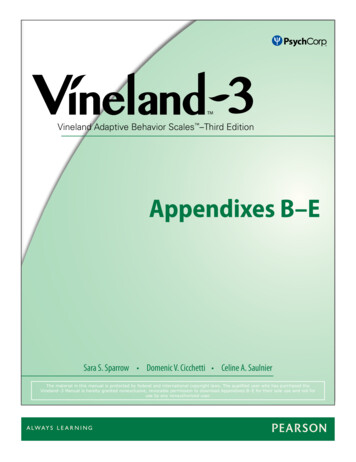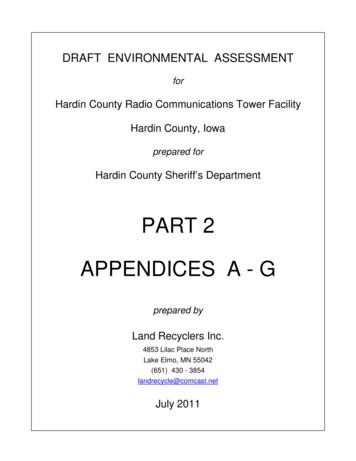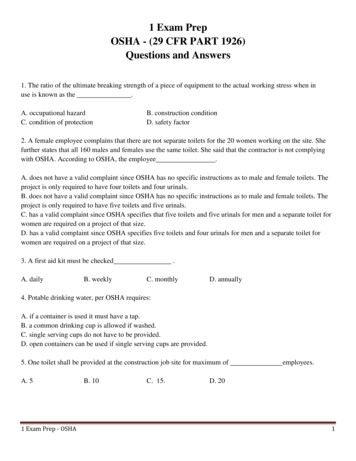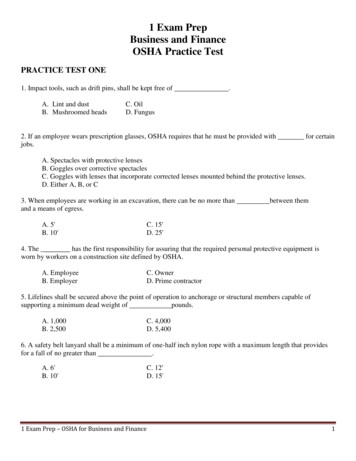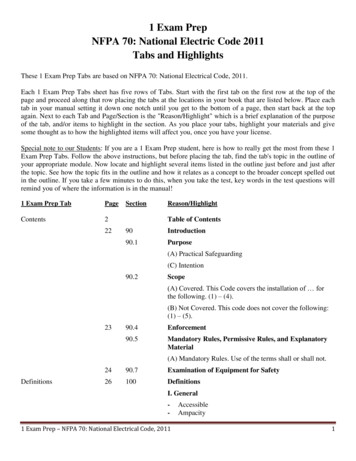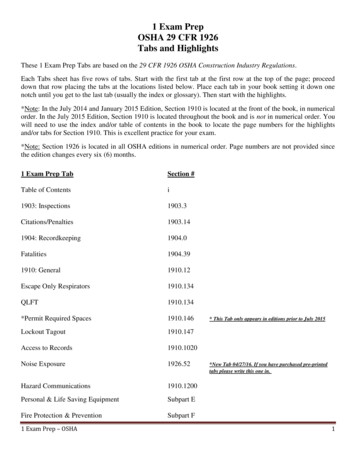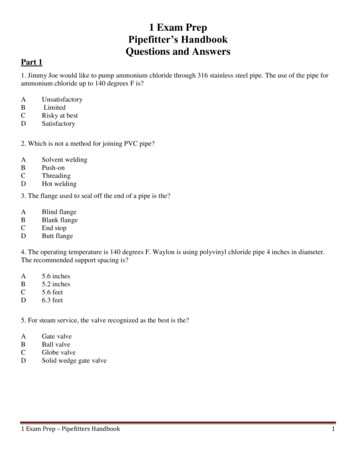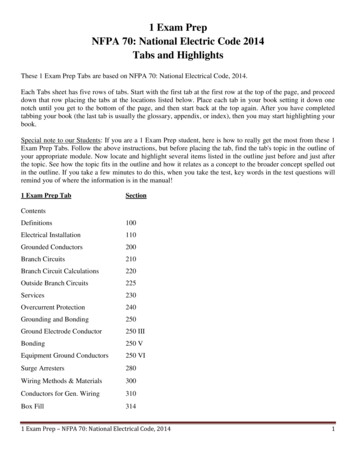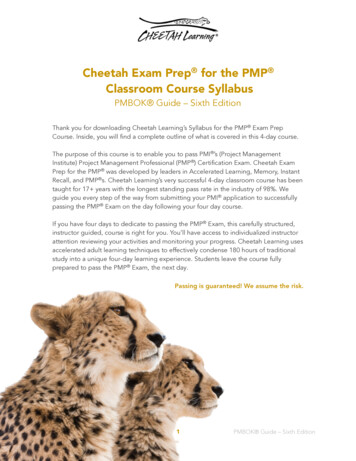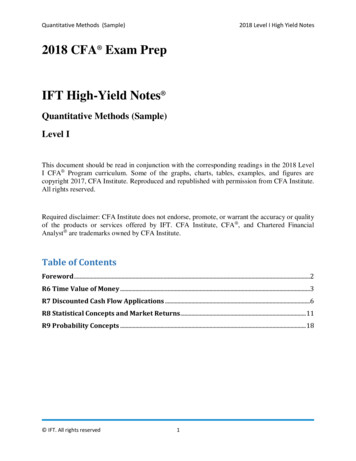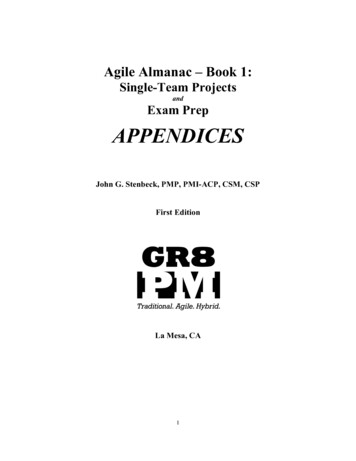
Transcription
Agile Almanac – Book 1:Single-Team ProjectsandExam PrepAPPENDICESJohn G. Stenbeck, PMP, PMI-ACP, CSM, CSPFirst EditionLa Mesa, CA1
Agile Almanac – Book 1:Single-Team Projects and Exam PrepJohn G. Stenbeck, PMP, PMI-ACP, CSM, CSPPublished by:GR8PM, Inc.1818 W. Francis Ave. #228, Spokane, WA 99205 USA(619) 890-5807custserv@gr8pm.com; http://www.gr8pm.com/All rights reserved. No part of this book may be reproduced or transmitted in any form orby any means, electronic or mechanical, including photocopying, recording or by anyinformation storage and retrieval system without written permission by the author, exceptfor the inclusion of brief quotations in a review.Copyright 2015 by GR8PM, Inc.ISBN Edition: 978-0-9846693-5-6Manufactured in the United States of America.This book includes material based on the Project Management Institute, A Guide to theProject Management Body of Knowledge, (PMBOK Guide) – Fifth Edition, ProjectManagement Institute, Inc. 2012.The book also contains many references to other registered terms such as PMP , PgMP ,CAPM , PMI-SP , PMI-RMP , or PMI-ACP , which are registered marks of the ProjectManagement Institute, Inc.This book expresses the views and opinions of its author. The information contained inthis book is provided without any express, statutory, or implied warranties. The author,GR8PM, Inc., its resellers, and distributors disclaim any liability for any damages causedor alleged to have caused either directly or indirectly by this book.2
ContentsAPPENDICES . 4APPENDIX 1: CERTIFICATION CHOICES . 5Obtaining the Certified ScrumMaster Certification . 6Obtaining the PMI-ACP Certification . 6PMP s and 1500 Hours of Agile Experience . 7APPENDIX 2: EXAM PREP “PRE-GAME” QUICK NOTES . 8Chapter 2: Agile From a PMP ’s Perspective . 8Chapter 3: Agile Project Management and Lean Principles . 9Agile Lexicon – Methodologies, Frameworks and Processes . 9Agile Manifesto and The 12 Principles . 9Principles Behind the Agile Manifesto . 9Agile Micro-Dynamic Workflow . 11Micro-Dynamic Environment . 11Micro-Dynamic Work Practices . 11Chapter 4: Scrum . 15Overview of Scrum . 15Chapter 5: eXtreme Programming (XP) . 18Workflow . 19Chapter 6: Lean Software Development (LSD). 22Workflow . 22Chapter 7: Kanban Basic Practices . 24Ceremonies . 25Chapter 8: Hybrid Project Management . 27Earned Value Management (EVM) . 27Agile Mindset. 27Chapter 9: Estimating and Derived Schedules. 29Chapter 10: Planning Poker . 30Chapter 11: User Stories . 313
APPENDICESThese Appendices provide information for practitioners considering pursuing recognitionas a Certified ScrumMaster (CSM ) or Agile Certified Professional (PMI-ACP ).For those undertaking the PMI-ACP exam they also serve as a final “pre-game warmup” reference just before walking into the testing center.They are updated as changes are made by the Scrum Alliance or PMI.There are two primary Agile certification choices with over 90% combined market-share.The Scrum Alliance offers the Certified Scrum Master (CSM). PMI offers the AgileCertified Professional (PMI-ACP ). The dozens of other certifications offered byvirtually unrecognized groups aren’t worth pursuing so they are not covered.Appendix 1 covers the prerequisites required for each certification as well as the processfor applying, passing the exam, and receiving and maintaining them.Appendix 2 provides “Quick Notes” for that final “pre-game warm-up.”4
APPENDIX 1: CERTIFICATION CHOICESSeveral years ago when “PMI-ACP and Certified Scrum Professional Exam Prep andDesk Reference” was published, GR8PM thought it would do well but never imagined itwould achieve over 1 million in sales in 26 months. However, two things were obviousfrom very early on. First, the PMI-ACP was going to be very popular. Second, PMIwould recognize that trend and invest in improving the PMI-ACP certification. Ourprediction was validated in the Fall of 2014 when PMI conducted an Agile RoleDelineation Study and revised the PMI-ACP exam in 2015.To begin, know that there are two primary certification choices of interest to 98% oftechnical professionals and Project Managers.The Scrum Alliance offers the Certified Scrum Master (CSM). If you are in a jobtransition, or expect to be at the time of this writing (December 2015), you shouldconsider adding the CSM to your resume. Likewise, if you are in software developmentand never intend to work outside the software industry, then the CSM is fine and shouldbe added to your resume.The Project Management Institute, PMI, offers the Agile Certified Professional (PMIACP ) certification and it has become the fastest growing certification in PMI history.For any serious technical professional or Project Manager, adding this to their resume isnot a matter of “if” but only a question of “when”. As we have explained to audiencesacross the country, PMI’s brand recognition and implied credibility among Fortune 2000companies and most public entities is dramatically higher than any of its competitors,including the Scrum Alliance.That is so, in part, because of the objective rigor that is required to obtain any of thevarious PMI certifications. As we began predicting three years ago, PMI has taken thenext step to improve the PMI-ACP by conducting a Role Delineation Study in the Fallof 2014 and re-piloting a new, more stringent exam in July 2015.That means that the career paths of serious technical professionals and Project Managersare on a direct collision course with the rising expectations of hiring managers. Thatmash-up will intersect at a point where the PMI-ACP is a threshold requirement. As it isnow with the PMP being a threshold requirement for any valuable Project Manager jobor promotion, so it will be with the PMI-ACP in the very near future. This fact is drivenby an organizational need for Agile leaders who can foster and manage the innovationthat defines success or failure on the battlefield for consumer dollars or taxpayer funding.And since it is only a question of “when”, most intelligent professionals are interpretingthe recent investment by PMI to improve the certification and make the examinationmore challenging as a trigger to do it sooner and save themselves from additional futuregrief.5
Along that same line, one additional GR8PM prediction is worth noting. We believe thatthe improvements being done to the PMI-ACP now by PMI are a precursor to the finalstep of fully integrating Agile best practices into the PMBOK Guide. Core Agile contentalready exists in the PMBOK Guide (Fifth Edition, Project Management Institute, Inc.2012) and we believe that the next edition of the PMBOK Guide will make that contenteven more clear and robust. Once that is done, we believe, the PMI-ACP exam will bebased on content in the PMBOK Guide and the need for a separate external list of bookswill be gone.As organizations pursue competitive advantage by leveraging Agile to deliver innovation,it will translate into hiring demands that will be a significant boon to PMI as it advocatesfor training in multiple Agile Frameworks. Conversely, significant challenges will likelyemerge for the Scrum Alliance as it advocates for training in a single Framework. That isbecause organizations want the right answer, customized to their needs, resources, andconstraints. They consider getting the right answer more important than dogmaticallegiance to any particular Framework.Therefore, acquiring the PMI-ACP certification will likely provide many careeropportunities. Being a PMI-ACP could give you the chance to lead dream teams onprojects of a lifetime. Additionally, if you feel like your job or your future is at risk,having the PMI-ACP could keep you from getting passed over instead of promoted, atthe next opportunity.All that’s left now is for you to decide when the time is right for you to add it to yourresume.Obtaining the Certified ScrumMaster CertificationAccording to the Scrum Alliance website, the requirements to become ScrumMastercertified include: Take a CSM course from a Certified Scrum Trainer. The classes are only allowedto be provided in an Instructor-led format and must be to days.Pass an online CSM test. Some CSM classes include time at the end for the entiregroup of students to log into the website and take the exam together as a group.A passing score requires correct answers to 24 out of 35 questions.After passing the CSM test, acceptance of the Scrum Alliance LicenseAgreement as well as completion of a Scrum Alliance membership profile areboth required.All of the information can be found on the Scrum Alliance website. Also available on thewebsite are the CSM Content Outline and Learning Objectives for potential students andthe CSM Validation Report for Scrum Alliance Members.Obtaining the PMI-ACP Certification6
One of the most common questions from PMP s is, “Do I qualify to sit for the PMIACP exam?” Their big concern is always about the requirement of having 1,500 hoursof Agile experience.PMP s and 1500 Hours of Agile ExperienceThat concern among PMP s points to a very big myth about PMP s thinking that theydon’t already use Agile practices. What seems to get missed is that even though the Agilevocabulary is different from the PMBOK Guide, an important number of the coreprinciples are exactly the same.If you take the time to remember back to that first time you opened the PMBOK Guideand started reading it, was your reaction, “Wow this is exactly how we talk at work?” Ofcourse it wasn’t and that thought is ridiculous. Nobody talks that way until after theybecome a PMP . So it shouldn’t surprise you that the Agile vocabulary is unfamiliarwhen you first start investigating it.One example of a core Agile concept can be seen in the graphical Work BreakdownStructure (WBS) that is studied as part of most PMP exam prep classes. The levels ofthe WBS are defined from the top down as Objectives, Phases, Work Packages, Activitiesand Tasks. Similarly, Agile calls the same logical device a Feature Structure, or a FeatureBreakdown Structure (FBS), and though it has a different naming convention, it servesthe same function. The levels of the FBS are most commonly defined from the top downas Product, Theme, Epic, Story and Task.Recognize that what they share in common is that at the highest level they have broaddetails and at the lowest level they have lots of fine granularity. Also, they are botharbitrary, logical devices for bucketing and managing information. Without this logicaldevice, if you try to carry all that information about all your projects around in your headat the task level, your head would explode.So, if you put the names the PMBOK Guide uses next to the names Agile uses for thevarious levels, what you find is that the definitions are virtually the same. Thus, everytime you’ve worked on a WBS, you were doing Progressive Elaboration andDecomposition, which are two core Agile practices.When you decide to pursue the PMI-ACP certification, the Almanac helps by detailing acomplete cross-section of core principles shared by Agile and Traditional projectmanagement.7
APPENDIX 2: EXAM PREP “PRE-GAME” QUICK NOTESThe Quick Notes are an excellent “parking lot” review on the day of the exam. Theycontain summarized content pulled together and condensed for use as a final, quick, andeasily accessible exam prep ritual. You have to know the content because Quick Notesare not a substitute for proper exam preparation, but they are a great, final “pre-gamewarm-up” on exam day.Chapter 2: Agile From a PMP ’s PerspectiveMany Agile best practices available come from the principles of Lean Manufacturing, asoriginally developed in the Toyota Production System with the insight and guidance ofW. Edward Demings1 and extended by
Single-Team Projects and Exam Prep John G. Stenbeck, PMP, PMI-ACP, CSM, CSP Published by: GR8PM, Inc. 1818 W. Francis Ave. #228, Spokane, WA 99205 USA (619) 890-5807 custserv@gr8pm.com; http://www.gr8pm.com/ All rights reserved. No part of this book may be reproduced or transmitted in any form or


